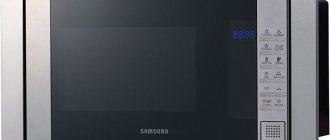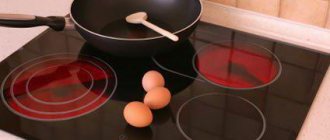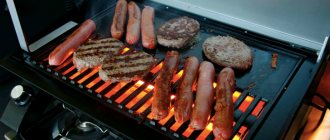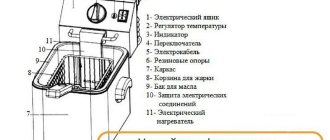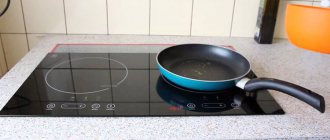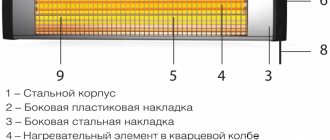Microwaves kill nutrients in food
There are rumors that microwaves "take away" all the goodness and nutrients, leaving food "empty", writes UK non-profit consumer organization Which? .
As WHO explains, in fact, the nutritional value of food cooked in a microwave is no less (and even more!) than food cooked on the stove.
Microwaves pass through the food, causing it to quickly heat both inside and outside. Thanks to this, food warms up faster than, for example, when boiling in a saucepan or frying in a frying pan. This allows you to preserve many vitamins and microelements that are destroyed by prolonged heating. In addition, microwaving usually requires less water - as a result, beneficial nutrients do not migrate into the water as much as they do in a boiling pan.
Which microwave is the best? See microwave oven ratings and research results .
Pros and cons of microwaves
You need to select a model depending on how you will use the microwave oven. However, the pros and cons of all microwave models are the same.
pros
- Using a microwave you can not only heat up, but also cook a wide variety of food from baked goods to yoghurts;
- No oil is needed when cooking or heating;
- Microwave ovens have compact sizes;
- temperature and time are set using programs, this significantly reduces energy consumption;
- in addition, you do not need to be constantly near the stove: you turned it on and went about your business;
- defrosting, heating and cooking food in the microwave takes much less time than on the stove;
- you won’t be hot in the kitchen: the microwave doesn’t heat the air;
- Vitamins in foods are mostly preserved.
Minuses
Microwaves have quite a lot of advantages, right? This seems like the perfect stovetop replacement, especially if you're trying to lose weight or avoid fried, fatty foods. But this technique also has disadvantages, although they are few.
- first of all, it is a slightly “artificial” taste: food cooked in a microwave has a different taste from food cooked in the oven or on the stove;
- harmful radiation, which many are afraid of, of course, exists. However, manufacturers are constantly working to reduce it: installing protective grilles and strengthening the body. By the way, radiation does not extend beyond 20 centimeters from outside.
A microwave is right for you if:
- you don’t have enough time to cook or heat food on the stove;
- You don't have the option of cooking on the stove or in the oven.
Microwaves are radioactive
Let's start with the fact that microwave and radioactive radiation, to put it mildly, are not the same thing, and they cannot be compared in any way. “The idea that microwave ovens pose a radioactive hazard seems to be based more on doomsday TV series than on any real scientific evidence,” notes Which?.
Roskachestvo previously explained
that there is no radiation in the microwave oven, instead there are ordinary electromagnetic waves, ultra-high frequencies, which are comparable to the frequencies of mobile communications rather than to radioactive radiation.
At the same time, the phones that we use every day freely emit radiation around them, and microwaves are “locked” in the oven. How does a microwave oven work?
Microwave radiation is created by a vacuum device in which radio waves are generated through the centripetal acceleration of electrons. Through a special window in this device, radio waves are emitted into a closed metal cage, but do not go out, but are, as it were, “reflected” and look for their target in order to heat it.
Heating occurs due to the movement of water molecules. The alternating electromagnetic field of microwaves causes them to rotate. As they rotate, they touch each other, which speeds up their movement. As a result, heat is generated.
Roskachestvo explains in more detail HERE
.
The radio wave passes through and goes out, and does not accumulate in the product and does not change the structure of the food.
After all, we do not emit radio waves after listening to the radio. WHO emphasizes that microwave ovens, when used in accordance with the manufacturer's instructions, are convenient and safe to heat.
The design of microwave ovens ensures that the unit only operates when the door is tightly closed, which traps the microwaves inside the unit. However, if the microwave is damaged, there may be some microwave leakage. But even in this case, the danger is not associated with radioactive radiation: the body can absorb microwave energy, and this, in turn, heats the tissue, reports Which?. However, for this to happen, it requires long-term exposure and more powerful than random microwave leaks.
Do microwaves really come through the cracks of a microwave oven?
To study microwave ovens, Roskachestvo conducted a corresponding leak test using a special detector. The detector “walked” through the door seal, window, control panel, ventilation holes, power cord and other external elements. In no case did we record any microwaves leaving the oven.
In any case, the microwave oven needs to be looked after: make sure that the door closes completely and that the locking devices installed on the door to prevent the generation of microwaves when it is open work correctly. The door seal must be clean and intact.
By the way!
Increased electromagnetic radiation (EMR) may be detected around a working microwave oven, but this is not a problem with microwave ovens specifically. It comes from almost all electrical appliances (TVs, kettles, computers, smartphones, etc.) when they are in use or even just plugged in. The intensity of radiation from each specific source is also different. And the longer we are in the electromagnetic field, the greater the chances of any consequences occurring. The danger is that without special equipment, we will never know whether we are currently exposed to such effects or not. Health consequences can include dizziness and insomnia, as well as pressure surges and arrhythmia.
Few people have the habit of unplugging the TV and microwave, but if suddenly some of your appliances emit strong EMR, then such measures will further protect you. Also try not to stand next to a working device, do not place powerful EMR sources near your head, monitor the condition of household appliances and read instructions for the proper use of household appliances.
Returning to microwave ovens, we note that in the Roskachestvo study, samples were also tested for electromagnetic radiation. They were all absolutely safe. Roskachestvo talks about this in more detail HERE .
Is it possible to heat food in the microwave for a child?
Rapid heating of baby food products other than in the microwave can destroy all of its beneficial and necessary vitamins and microelements for the baby. It is better not to expose milk formulas, which are similar in composition to mother's breast milk, to electromagnetic radiation, which destroys the structure of the mixture and destroys vitamins.
Reasonable precautions must be taken, bearing in mind that:
- the final conclusion of scientists that microwave ovens cause cancer has not been made;
- electromagnetic waves cause food molecules to rotate at high speed, so it is recommended to heat baby food correctly: do not turn it on at full power and heat it in short stages: heat, stir and heat again;
- Using the microwave too frequently is not recommended.
We recommend reading: The health benefits and harms of dishwashers
Microwave food causes cancer
Fears associated with the development of cancer arise either because of “radioactive radiation” (which we have already dealt with), or because of “changes in the structure of food” (we also dispelled this myth). In any case, all these fears are unfounded.
“Evidence shows there is no link between microwave oven use and an increased risk of cancer. In the context of the risk of this disease, what you put in the microwave is much more important. So read labels and try to reduce sugar, fat and salt levels in foods,” comments Which? UK Cancer Research Charity Specialist Zara Schneider.
LiveInternetLiveInternet
Quote from adpilot
Read in full In your quotation book or community!
INVALUABLE TIPS FOR YOUR MICROWAVE...
Microwave ovens are used in a variety of ways these days and are much more than just a device for heating food. In fact, professional chefs and culinary enthusiasts have invented a lot of different recipes for them. Baked goods, stews and a variety of snacks are now prepared in the microwave. It's hard to believe that all complex kitchen processes, such as frying, baking, grilling, can be carried out very successfully in this small device. Below are some genius cooking tips that will help you get the most out of your microwave and Chop Onions Without Tears
You can put an end to onion chopping tears once and for all by simply cutting off both ends of the onion and placing it in the microwave. Heat the onion at full power for 30 seconds and the pores secreting juice will dry out. The taste and all the beneficial substances will remain in place, but the enzymes that provoke lacrimation will evaporate, and the onion will be easy to chop without shedding a tear. Bringing back the aroma of long-stored spices
Spices, nuts and seasonings can be restored to their original flavor after long storage. To do this, just heat them in the microwave for 15 seconds at full power. Bringing potato chips back to life
Those who want to restore the crispiness of chips can easily do this using the microwave. Place several disposable paper towels in it along with the chips, and excess moisture during heat treatment will be completely absorbed by them. Even a short heating will easily bring your crispy chips back to life. “Reanimating” stale crackers
It's not just chips that can be restored to their crispness; stale crackers and cereals will also benefit greatly from the same trick! In this case, there is no need for paper towels. Simply heat the crackers for thirty seconds in the microwave and they will taste like freshly baked. Bringing freshness back to stale bread
Stale bread can be successfully “refreshed” by wrapping the slices in a damp cloth and heating in the microwave for 10 seconds at full power. If necessary, the operation can be repeated until the desired softness of the bread is achieved. Cooking "low-fat" bacon
Cooking bacon chips in the microwave is much faster and healthier than traditional cooking. Place paper towels on a plate, place a few slices of bacon on top, and cover with paper towels to avoid grease splatters. Set the time to 3 to 5 minutes on high power and you will get delicious chips without excess fat. Defrosting sandwiches and baked goods
Typically, frozen sandwiches and baked goods become soggy and limp when reheated. This can be avoided by wrapping them in a paper towel. You will see that the moisture will be absorbed into the wipes instead of remaining on the surface of the product. Cooking fried nuts
You can toast cashews or almonds much faster in the microwave than in a conventional oven. Simply scatter the nuts on a microwave-safe plate and set the timer for 1 minute on high. Repeat this operation 4-5 times, stirring the nuts in between. Container suitability testing method
If you need to test a plastic container for microwave safety, place a mug of cold water in it and heat it for one minute. If the water turns out to be hot, but the container remains cold, everything is in order. If the container gets hot, you will have to discard it. Cooking express scrambled eggs
You can cook delicious scrambled eggs in the microwave in 3 minutes. Break the eggs into a cup, adding salt, cheese and herbs as desired, set the power to high. When you hear the ready signal, an amazing discovery awaits you - a delicious dish comes out almost instantly! Decrystallization of honey
Does honey seem too thick to you? If it crystallizes, microwave the jar, uncovered, for 2 minutes on low power. The honey will become fluid again and will fully retain its magical taste. Soak lentils and beans
The microwave can help speed up the soaking of lentils or beans, which usually takes overnight. Place the food in a special bowl, add water, add a pinch of soda and heat for 10 minutes. Then leave to cool for 30-40 minutes and you will have beans ready for further processing. Drying herbs
To properly dry your herbs, use the following advice. Heat them in a container for 2-4 minutes at high power, first transferring them with paper napkins. Then you should lightly crumple the napkins with grass, repeat the operation and remove the finished dried plants. How to melt chocolate correctly
You'll probably need a quick way to make lump-free hot chocolate. Grind the bar as thoroughly as possible and place the chocolate pieces in a special bowl in the microwave for 15 seconds. Then repeat this operation, stirring the product lightly in between until the desired result is achieved. Bake fish fillet
To cook fish fillets in the microwave, you must first dry them thoroughly. When placing the fillets on the plate, ensure that the tails intersect, creating the same overall thickness as the rest of the dish. It is necessary to remove the fish when it still retains partial transparency. This may seem strange to you, but the fact is that the cooking process continues for some time after the stove is turned off. But by leaving the fish to cook for a few more seconds, you can easily dry it out. Baking a chocolate cupcake
Chocolate cake lovers can easily get it in one minute and forty seconds. You need to mix sugar, cocoa, salt, cinnamon and flour in a bowl. After obtaining a homogeneous mixture of dry ingredients, you need to pour in the liquid ingredients one by one: water, vanilla ice cream and vegetable oil. Mix everything again until the lumps completely disappear and heat in the microwave at high power, anticipating the imminent enjoyment. Increasing the volume of juice obtained from lemons and limes
Imagine making lemons or limes juicier and easier to squeeze by placing them in the microwave for 10-20 seconds on high power. Then cut up the lemons, put them in the juicer, and you'll be surprised how much juicier they are than usual. Perfect poached eggs
You can make wonderful poached eggs in the microwave by cracking the eggs into a special bowl of boiling water and a splash of white vinegar. You need to insert a couple of toothpicks into the yolk, cover the bowl with cling film and only then put everything in the microwave. The dish is cooked at maximum power for 30 seconds. After this, the egg is carefully turned and the operation is repeated for 20 seconds, until the product is fully cooked. Peel the garlic
Peeling garlic cloves can be a hassle, especially if you're in a hurry. The problem has a simple solution - put the head of garlic in the microwave and heat for 15 seconds at full power. The husk will become moist and can be easily removed. Whipping cream
Need whipped cream for hot drinks? Simply pour the cream into the container of your mixer until it is half full. Close the lid and beat them until foam appears. Then remove the lid and microwave the container for 30 seconds on high. Everything is ready - you can take the foam with a spoon and place it in cups with hot drinks. Removing peels from fruits and vegetables
It’s not an easy task, isn’t it, to peel tomatoes or, say, peaches? Here again, a microwave can be of invaluable help! Simply heat the fruit for 30 seconds on high and leave to cool for a couple of minutes. You will witness a small miracle: the peel itself will begin to fall away right before your eyes and your goal will be achieved without effort.
Source https://ruvv-uroki.blogspot.ru/2014/07/blog-post_3060.html
The microwave should not be used by anyone who has a pacemaker.
According to this statement, in order to disrupt the pacemaker settings, it is enough to use a microwave oven.
Electromagnetic interference from household appliances can, in some cases, slightly change the settings of pacemakers. According to the British Heart Foundation, to protect your pacemaker from any electromagnetic interference, just stay 15cm away from the microwave when it's on. However, some types of household appliances can be truly dangerous - they are listed in the instructions for using the pacemaker, information about this should also be in the instructions for the device itself.
But the following opinion is no longer a myth:
It is dangerous to heat food in plastic containers
While some people are afraid of radioactive radiation, others calmly heat food in toxic plastic containers, believing that since the container is food grade, there is no need to worry about the migration of phthalates into the food.
Plastic may contain toxic bisphenol A, phthalates and other potentially dangerous compounds that migrate into food when heated. It is believed that plastic labeled PP 5 is safe for food (including when heated), but in a microwave oven the temperature can be even higher than the limit mark for PP 5 (which is more than 100 degrees). To confirm the product's suitability for use in microwave ovens, the manufacturer must conduct the necessary tests.
Therefore, plastic containers for heating in a microwave oven must have a special marking (microwave oven pictogram). Not all containers can boast of such markings. Therefore, if you do not see a special sign on the food container, it is better to always transfer the food into glass or ceramic containers.
Read more HERE .
The benefits of a microwave
The functionality of microwave ovens is impressive. They heat food, defrost it, and allow you to bake meat, fish, and baked goods. Thanks to uniform heating of food, cooking time is noticeably reduced.
Advantages of a microwave oven:
- Compact sizes. Each user can choose a microwave oven in accordance with the dimensions of the room. Modern manufacturers produce built-in models that are perfectly hidden in kitchen cabinets without disturbing the style of the space;
- No carcinogens. When heating food, no oils or fats are required. Food does not burn from the walls of the cookware. Therefore, the body is protected from consuming excess amounts of carcinogens;
- Saving time and electricity. All programs work automatically. Thanks to optimal temperature conditions and limited time, energy costs are reduced. Plus, you don't have to stand at the microwave. It will automatically turn off at the end of the program time;
- The temperature does not change during cooking. When using conventional stoves, the air space of the kitchen heats up;
- The vitamin composition of food products is not destroyed. Studies have shown that when cooking dishes in a microwave oven, up to 98% of vitamins are retained in them, whereas with conventional heat treatment it is within 40-60%.
Many people use the microwave to prepare dietary meals. Recipes with a minimum amount of fat are lower in calories. They do not burn or fry, which means they help remove toxins and waste from the body.
